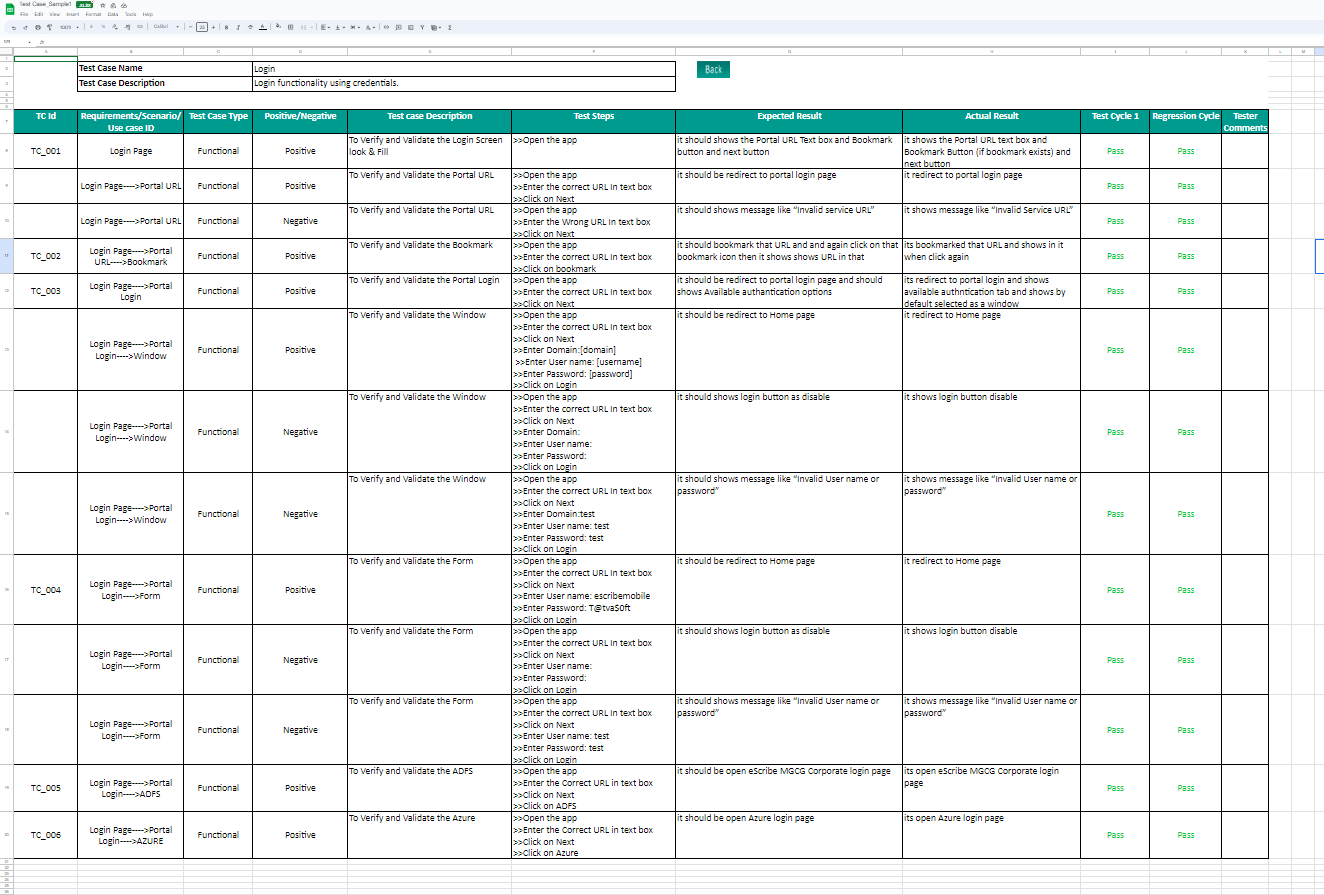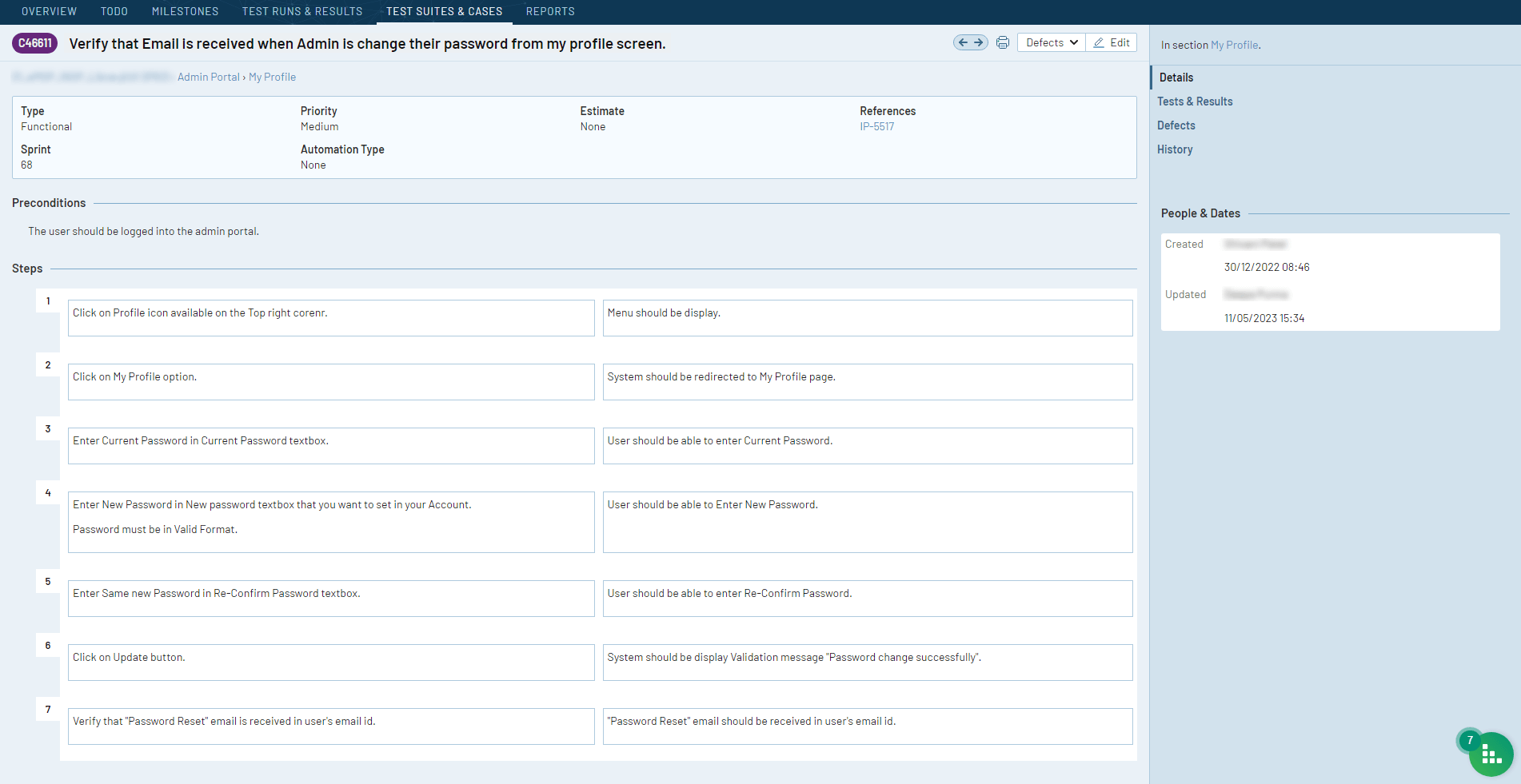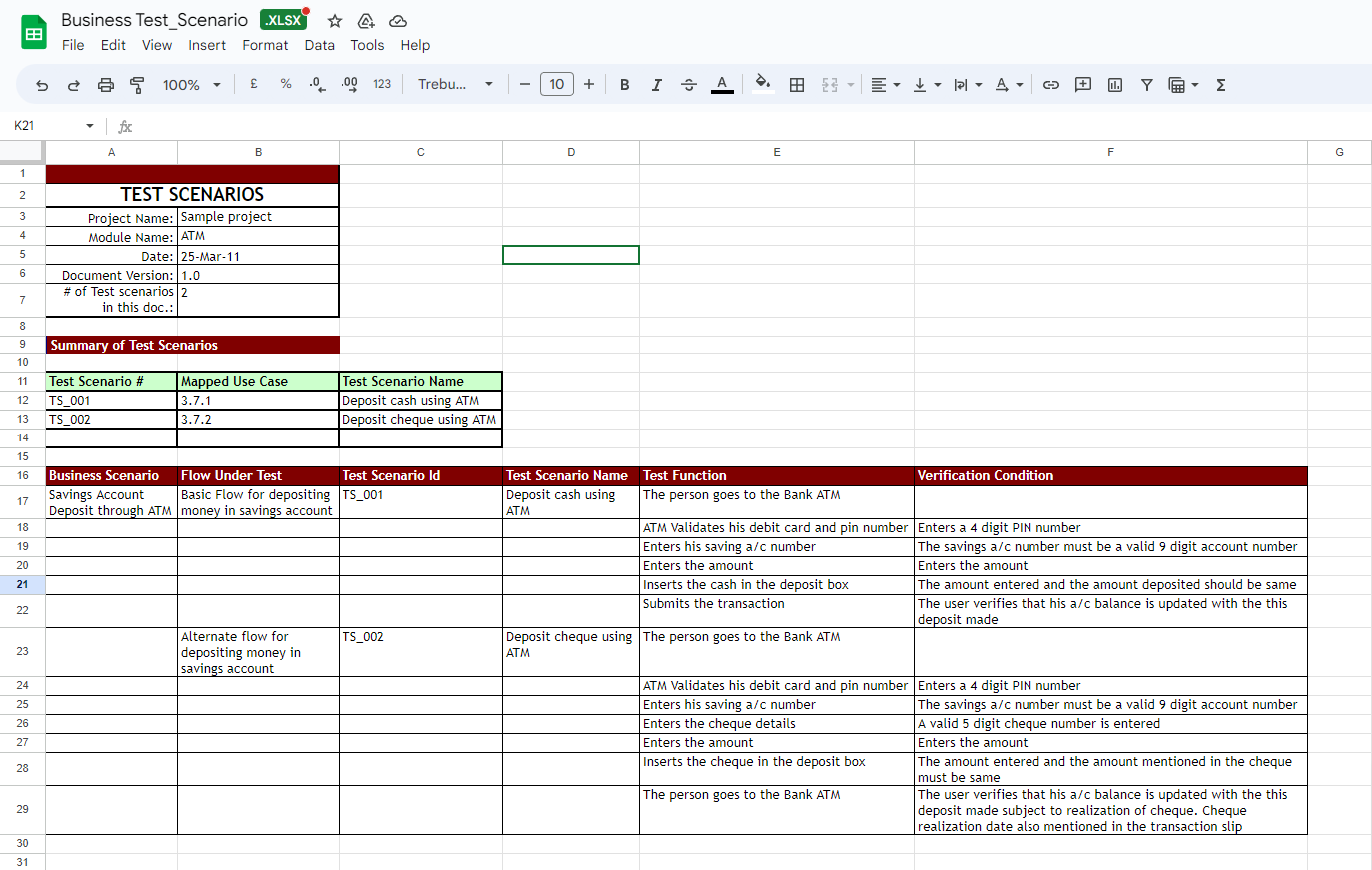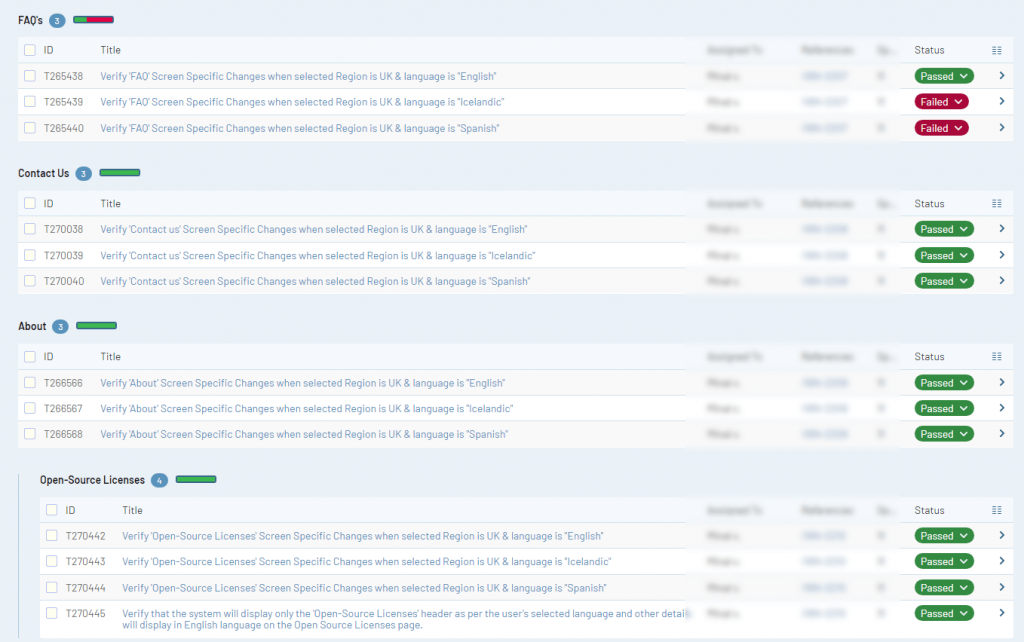
Test Case and Test Scenario are two key forms of the software testing process. As a part of QA services, these are regularly utilized to aid in their testing efforts and are included in those testing documents.
In this article, we’re gonna have a Test case vs Test scenario comparison. Find out how they vary, what benefits they offer, and more by reading.
1. What is the Test Case?
A test case is a document written for software testing teams that focuses on a single, narrow aspect of the program being tested. A Test Case includes test phases, test information, precondition, and postcondition designed for a particular test scenario to check any prerequisite. Test procedures predicted outcomes, actual outcomes, current status, etc. are often detailed here.
Have a look at this tweet:
What is test case ❓️
— kaveri (@kaveri04) July 29, 2022
Test case is a detailed step- by -step procedure, along with expected result
Eg : Test case to test Login to website using gmail in the image below
Test cases can be positive or Negative pic.twitter.com/6sc87ae2oN
Test cases are detailed documents that lead testers through the QA process by specifying not just what to test, but also how to test it. The nature of the program can be better understood if the testers compare the predicted outcomes with the actual results.
With a test case document, you can be confident that your test engineer won’t miss any crucial tasks in their day-to-day testing mission. In addition, writing test cases aid in task allocation for testing team managers. This means that the test cases are more complex and time-consuming to build and operate than test scenarios. Using an invalid password to log in is one possible use for a test case.
2. When Should You Write Test Cases?
A test case specifies precisely which criteria must be met and what measures must be taken to validate the precision of a system. In addition, the required input values for triggering a software function and returning its associated output are specified.
When all test cases have been defined, they should be analysed together to determine whether they correspond to all the software specifications and extant features.
In essence, test cases are written to give the software testing process shape and variety. They monitor the number of devised and executed tests, as well as the pass/fail ratio. They also disclose any unproven features that, if released into development, might interfere with the user experience.
3. How to Write a Test Case?
The test cases must be well-written, comprehensive, and correct, as they will serve as the roadmap for the testers. Here are a few principles to follow while either creating new test cases or re-evaluating the ones you already have.
- Determine in advance what you want the scope of the test to be.
- Make sure the test case can be quickly grasped and executed by testers.
- Master appropriate testing strategies and implement them.
- Create a new test case ID each time.
- When conducting tests, refer to the requirements traceability matrix for clarity.
- Each test should have an explicit description.
- Include necessary pre- and post-requisites.
- Clearly state the desired outcome.
- Make use of adequate testing procedures.
- Before moving further, get your test strategy approved by your peers.
4. What is a Test Scenario?

A test scenario is an advanced explanation of how a specific application function or feature should operate. It normally comprises an overview of the actions required to evaluate the function or feature, as well as the expected outcomes. In other words, a test scenario describes the procedures a tester must perform to ensure that an application functions as anticipated.
Have a look at this tweet:
What is a test scenario ❓️
— kaveri (@kaveri04) July 29, 2022
A functionality , or behavior of the code using different scenarios
Eg : These are different scenarios for Login page
1. Login to website using gmail
2. Login to website using gitHub
3. Login to website using username and password
Companies and teams using agile techniques for creating test scenarios to be helpful and time-saving. Each member of the testing team may view the document, see immediately which tests have been completed, and proceed to the given test scenario. Rather than spending time inputting a lot of test data on a complicated file, testers may focus on the testing process thanks to this document. A good test scenario may read, “Verifying the software’s login capabilities.”
5. When Should You Use a Test Scenario?
A test scenario is useful when you need an example of how an aspect or feature of software should perform. Test scenarios are less specific than test cases and eliminate input values and predicted outcomes. This makes them ideal for gaining a broad understanding of how a program should operate.
6. How to Write Test Scenarios?
Below are the actions you need to take as a tester to construct test scenarios.
- Check out the software’s test artifacts like BRS (Business Requirement Specification), SRS (System Requirement Specification), and FRS (Functional Requirement Specification).
- Identify all technical considerations and goals for each request.
- Explore any and all possibilities for the user’s engagement with the program.
- Identify potential hacking targets and all the ways the system might be misused.
- After reviewing the scope specification and finishing the scheduled analysis, create a list of potential test cases to validate each function of the application.
- Once you’ve found all the test cases, make a traceable matrix to check if every specification has a corresponding test case.
- The project manager considers every option. After then, the other people involved in the project look them through.
7. Key Differences between Test Cases vs Test Scenarios
Here are the key differences between test case and test scenario.
| Test Case | Test Scenario |
|---|---|
| All of an app’s features may be put to the test with the use of test cases, which consist of predefined actions, data, and expected results. | A test scenario is a high level document that consists of multiple test cases that cover end to end functionality. |
| Complete focus on testing strategies, including both what and how to test. | More emphasis is placed on the “what” of testing than the “how.” |
| Each step, requirement, intended outcome, etc. is specified in the test case. Consequently, the procedure is very clear. | We can sum up test cases in a sentence. So, there is always room for interpretation throughout the testing phase. |
| The majority of the time, test cases originate from test scenarios. With a single testing scenario, several test cases may be generated. | From characteristics like the BRS, SRS, etc., test scenarios are formulated. |
| It facilitates thorough exhaustive testing of software programs. | It facilitates an agile method of testing overall functioning. |
| Cases in testing are simple procedures. | Scenarios in testing are major events. |
| More manpower is essential for writing up and running test cases. | There is a significant saving in both time and money when employing test scenarios for development and testing. |
8. Test Case Example
Let’s make a test scenario out of the basic process of logging onto a website. But first, before you start coding the test:
- Get your hands on a mockup of the login screen and put it through its paces.
- Get your hands on the project’s SRS and FRQ documents.
- The test case may be written once a prototype has been created and requirements documents have been compiled.
Respond to the questions in the test case by outlining the necessary processes and conditions:
- For this analysis, which fixed or variable controls and fields are shown to the user? How can you be confident that they are performing as expected?
- Are the login button and all other dynamic links reacting properly to clicks and taps?
- Is there a dependable connection between the UI and the site’s database? For instance, once the user logs in with their username and password, the program must validate this information against the appropriate back-end database and either grant or deny access.
- Do all subsystems that make up the feature function as intended? Does it, for instance, immediately send an email to the user’s assigned email address including the reset link once the user presses the “Forget Password?” link?
- Does the story progress normally? Is the URL route correct across all browsers and able to permit login with the right passwords being inputted?
- Can the same experience be had from a mobile browser with the appropriate credentials?
- What occurs when a user exits their session? Is the user redirected back to the sign-in page?
- What happens if a user makes a typo when trying to log in? Do the appropriate error messages appear when an issue arises?
Here are the examples of executing a test case.
Using spreadsheet:

Using TestRail (Test activities management) tool:

9. Test Scenario Example
Take online shopping’s search feature as an example. Ultimately, we want to know if the consumer can find the specific things they’re seeking after conducting a search.
A test scenario may include numerous test cases. Several test cases may be derived from this situation to ensure that the search function is functioning as intended in all respects. You may create test cases for things like:
- Can you easily find the search bar? Is it aesthetically pleasing and conveniently located? Do additional pictures, buttons, or links become blocked?
- Does the search bar provide appropriate results when you type in particular terms or words? Do you get the outcomes you expect?
- Can you refine your search by cost, product grade, product substance (like fabric), country of origin, style, size, return policy, and so on?
Here are the examples of executing a test scenario.
Using spreadsheet:

Using TestRail (Test activities management) tool:

10. Conclusion
In conclusion, thorough documentation of the testing process gives managers the opportunity to keep everyone on the same page and maintain quality control.
From a user’s perspective, test cases encompass the whole range of the software’s capabilities. The test scenarios are meant to be realistic representations of actual circumstances, with a primary emphasis on what should be tested at a low level of action specificity. Many companies prefer test scenarios, but test cases are more comprehensive documentation, as they describe every step of testing a certain software functionality. Each test case includes detailed instructions on what to do and how to test it.
Both types of test documentation have their uses, help testing groups succeed, and reduce the possibility of mistakes.




Anyone involved in software testing should read this article. It provides detailed differences between test cases and test scenarios. And it made me feel more confident in my ability to create and execute test cases.
Great comparison between test cases and test scenarios. I really like that you added tweets and images to make it easier for me to understand. Thank you for sharing this article.